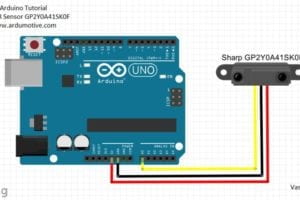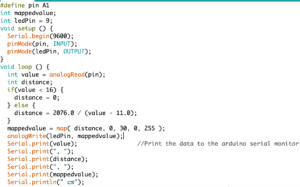Partner: Zhiqiu Wang
Circuit 1: Blink with an infrared distance sensor
Components:
1 * Arduino Uno
1 * infrared distance sensor
1 * LED
Jumper cables
Processes and problems we encounter:
We first connected the Arduino with the infrared distance sensor like the picture above.
This recitation was not like any previous recitations because we were not provided any visual aids of the circuit. But meanwhile, we could also explore something new and add our creativity into our work. We chose the infrared distance sensor and wanted to build a circuit in which the brightness of the LED can be adjusted to the distance the sensor sensed. However, at first, we could only let the LED on when the distance that sensor sensed was above some number and let it off when the distance was under some number. We copied some language from examples tested it. At first, the serial monitor only showed two numbers which were not even close to the fact. We asked an assistant for help and found out that we mistakenly typed 0 as our input pin number but assemble the wire into port 2. We made some adjustment and tried again. This time, the circuit worked well.
Circuit 2: Fade with an infrared distance sensor
After our first success, we still wanted to try on the fading circuit. We used the mapping formula to transit the distance that the infrared distance sensor sensed into numbers between 0 to 255. We were confused at first about how to write the Arduino. After perusing and contemplating the programming, we found that there were only two lines we needed to copy from the example the website provided. Under the guidance of professors, we made the completed code, which was much cleaner and more simple than I thought it would be.
This is how the code looked like at last.

Question 1:
What did you intend to assemble in the recitation exercise? If your sensor/actuator combination were to be used for pragmatic purposes, who would use it, why would they use it, and how could it be used?
We intended to assemble a device in which the brightness of LED can adjust to the distance that the sensor sensed. I think it can be used as an energy-saving street lamp. The government can install such a device along the roads which are remote and far from the city center. Because there is usually few cars who will pass these streets, keeping all the street lamps there at full brightness can be a waste of energy. This device can save energy at a large degree. They can improve lighting levels when the infrared distance sensor detects cars coming and turn the brightness down when there are no moving things on the road.
Question 2:
Code is often compared to following a recipe or tutorial. Why do you think that is?
When start coding, we need to first consider what variables we need in the following lines and present them at the very beginning. For example, in our second circuit, we defined pin as A1 and ledPin equals 9. Thus when we input pin or ledPin again afterward, the computer can recognize these “signals” and decide what we want it to do. This process is similar to making a recipe. The recipe maker will always present the food material this specific dish needs at the very first, then use these materials to produce something else.
Question 3:
In Language of New Media, Manovich describes the influence of computers on new media. In what ways do you believe the computer influences our human behaviors?
The computer serves as a medium in communication between human. Network drives social productivity to develop at a faster rate. There are increasing channels for people to understand and disseminate information. People can complete work and study tasks without leaving home, allowing everyone to save more time to deal with other things so that people are liberated in action and thought. However, almost every aspect of computers influence on human behavior has two sides. For example, in job marketing, computers replace workers of those hazardous work, but computers also converted them into unemployed people. Since the current network development has not yet reached a relatively perfect stage, the network still has a lot of virtuality and unreality, which leads to the development of the struggle in the ideological and political fields on the network.